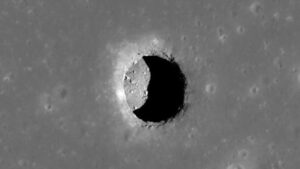On the fringes of our planetary neighborhood, a phantom planet may be lurking. Scientists have long debated the existence of a ninth planet, sometimes called Planet X, based on unusual gravitational anomalies beyond Neptune.
However, Planet X remains a ghost. Does it exist? Or is this just the wishful thinking of ambitious astronomers?
Background

Neptune. Photo: 24K-Production/Shutterstock
In 1846, Neptune’s official discovery changed astronomy. Astronomers hunted the night sky for more celestial bodies. One of them was American astronomer Percival Lowell. Lowell was convinced that a ninth planet existed beyond Neptune.
Initially, the title of ninth planet went to Pluto, but much to the public’s dismay, astronomers downgraded Pluto to dwarf planet in 2006.
Lowell believed that the odd orbital patterns of Neptune and Uranus meant they were being influenced by a large mass. This was not a wild theory, planets and other large celestial bodies do influence each other. While Lowell himself was unable to achieve his dream of finding Planet X, subsequent astronomers kept up the search well into the 20th century. More recently, new computing models and calculations have breathed fresh life into the hunt.
Evidence of Planet X
In the 2010s, two astronomers from the California Institute of Technology provided potential evidence of Planet X’s existence. They came across discrepancies in the orbital behaviors of dwarf planets and other Trans-Neptunian Objects (TNOs). TNOs include dwarf planets and bodies of rock and ice. Some examples include Pluto, Charon, Eris, and Sedna. The research showed that some of the TNOs orbit in clusters. This is highly unusual unless something is influencing them.

A TNO called Charon, a moon of Pluto. Photo: Joshimerbin/Shutterstock
This region of TNOs is called the Kuiper Belt, the origins of which are still a mystery to scientists. This is because this region of our Solar System is incredibly dark and does not reflect much light from the Sun. Telescopes are unable to see the region clearly and it is hard for scientists to get accurate data, so they tend to rely on hypothetical calculations. It is tough work, if there is a Planet X, it is hundreds of times fainter than Pluto.
According to NASA, Konstantin Batygin and Mike Brown’s mathematical model suggests that Planet X might be 10 times the mass of Earth and could take approximately 20,000 years to orbit the Sun. This orbit would have a “highly elongated orbit in the outer Solar System,” according to the Caltech website.
Theories
Maybe Planet X does not exist at all. National Geographic writer Nadia Drake proposes that “perhaps, Planet Nine is an apparition, its supposed gravitational handiwork a false signature created by a small number of misleading data points.”
We have no visual evidence of a ninth planet and scientists have suggested that it might be impossible for planets to form so far from the Sun in an area with little gas. Because we do not have sufficient data from the Kuiper Belt, scientists’ calculations could be off, and they have been wrong before. For example, previously, scientists miscalculated Neptune’s mass.
According to the BBC, physicists Jakub Scholtz and James Unwin believe that Planet X is not a planet but rather a primordial black hole. Scientists like Stephen Hawking believe this type of black hole is a remnant of the Big Bang. Supposedly, they range from the size of an atom to 100,000 times larger than our Sun.
Scholtz and Unwin think this specific black hole is the size of a bowling ball. This theory would explain the gravitational and orbital anomalies in the Kuiper Belt and explain why we’ve never picked anything up using telescopes.

2I/Borisov Comet. Photo: Hubble Telescope/NASA
Another scenario posits that Planet X is a rogue planet that has drifted into the Solar System after disconnection from its nearest star. Interstellar objects entering the Solar System have been recorded previously. Recent examples include the cigar-shaped object Omuamua (2017) as well as the Borisov Comet (2019). Rogue planets do exist in the Milky Way, maybe in the trillions.
The rogue planet hypothesis is also connected to a popular doomsday theory. This theory states that a rogue planet called ‘Nibiru’ floats freely in space and will eventually collide with Earth sometime in the early 21st century.
Conclusion
For now, we only have theories and computer simulations, we have no physical evidence. “What we’re seeing is an early prediction based on modeling from limited observations. It’s the start of a process that could lead to an exciting result,” Jim Green, the director of NASA’s Planetary Science Division explained. But that result could be that it doesn’t exist.
Researchers believe the Vera Rubin Observatory in Chile might be able to provide us with answers. The observatory will open in late 2023 or 2024. One of its missions is to focus on the Kuiper Belt and find Planet X. It will search two-thirds of the sky.
As our technology continues to advance, perhaps we’ll finally settle the debate over Planet X.






